Anxiety Monster Drawing 101 – Artfully Conquer Your Fears

Why Creating an Anxiety Monster Drawing Can Transform Your Mental Health
Anxiety monster drawing is a powerful art therapy technique where you visualize your anxiety as a creature and draw it on paper. This simple practice helps you externalize overwhelming feelings, gain control over your emotions, and process anxiety in a healthy way.
Quick Overview: How Anxiety Monster Drawing Works
- Feel: Notice where anxiety lives in your body and what it feels like.
- Visualize: Imagine your anxiety as a specific creature with unique features.
- Draw: Put that monster on paper using any art supplies you have.
- Interact: Talk to, comfort, or dispose of your drawing for emotional release.
Research shows that even brief periods of art making can significantly reduce anxiety. When you draw, your brain’s fear center (the amygdala) becomes less active, and mindfulness increases. You’re literally rewiring your brain to feel calmer.
The beauty of this technique lies in its simplicity. You don’t need artistic skills or expensive supplies. Giving your anxiety a physical form—whether it’s a “scrappy, exhausted looking fluff” or a fierce dragon—makes it feel smaller and more manageable.
As Nate Raine, CEO of Thrive Mental Health, I’ve seen this technique help people in our behavioral health programs gain clarity and control. My work in mental health innovation has shown me that creative tools like this can be just as powerful as traditional therapy methods.
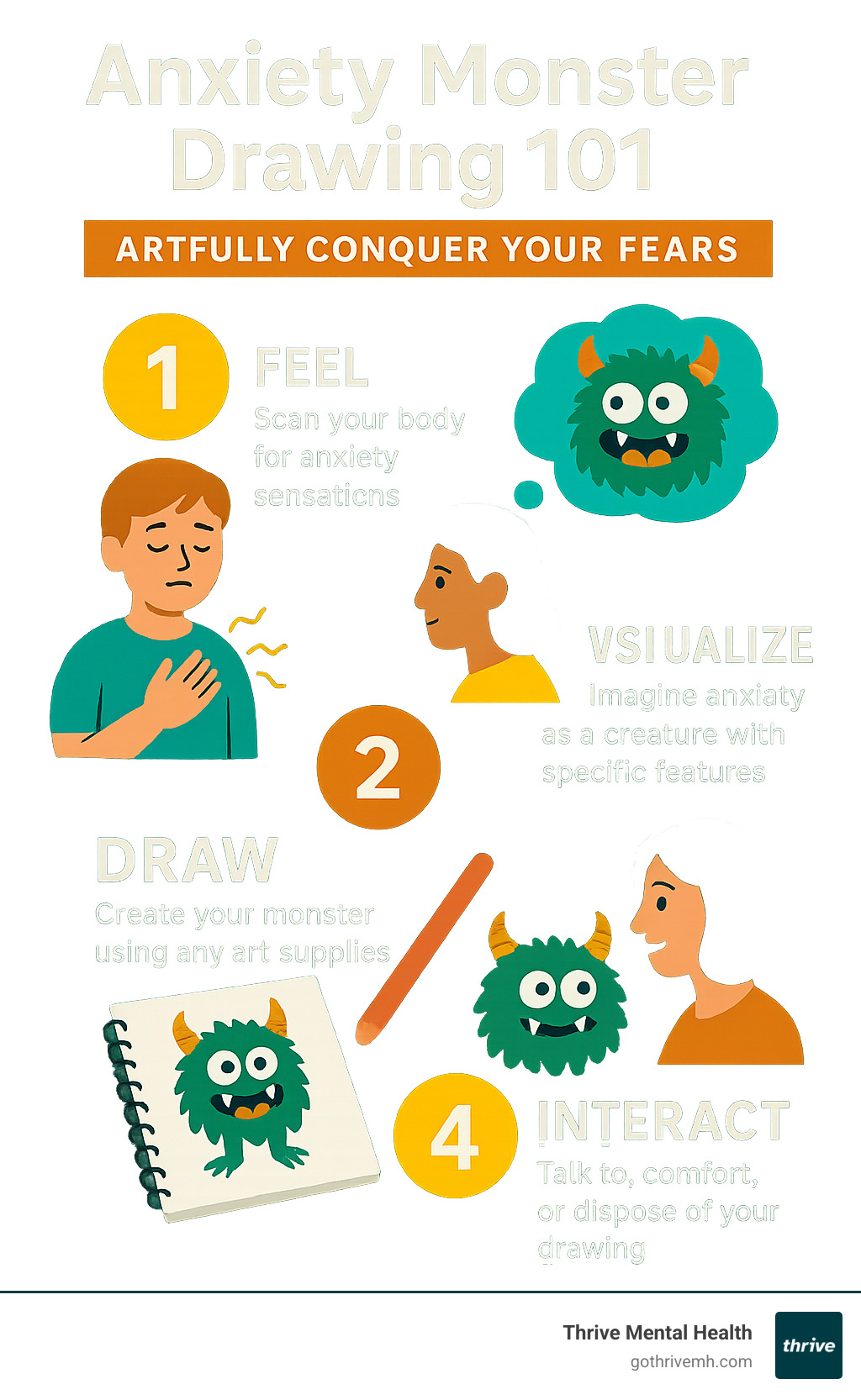
Why Turn Your Anxiety Into a Monster? The Power of Personification
Turning an abstract feeling like anxiety into a tangible “monster” is a surprisingly effective coping mechanism. This practice, called personification, externalizes your internal struggles, giving you a sense of distance and control. Instead of feeling consumed by anxiety, you can look at it, interact with it, and begin to understand it. Giving anxiety a form—whether a “scrappy, exhausted looking fluff” or a fire-breathing dragon—makes vague body sensations feel smaller and less oppressive.
Understanding the Concept
At its core, personification gives human or animal traits to abstract concepts. Applying this to anxiety transforms something overwhelming into a concrete entity. This process creates emotional distance, allowing you to observe your anxiety rather than being engulfed by it. It also initiates a dialogue. Instead of pushing anxiety away, which often makes it louder, you invite a conversation. As one expert suggests, anxiety can be seen as an “overprotective pet” trying to keep you safe. This perspective encourages comforting it rather than fighting it.
Creating details for your anxiety monster drawing demystifies it. For children and adults alike, visualizing a worry as a “being” helps them feel a sense of control. By making anxiety concrete, we can explore its nature, understand its triggers, and reduce its power over us, gaining more insight into Anxiety Symptoms.
How Personification Reduces Stigma
One of the biggest benefits of personifying anxiety is its impact on stigma. By giving anxiety a visual form, we create a shared language. Projects like Toby Allen’s ‘Real Monsters’ illustrate how artistic representation can be a powerful tool for mental health awareness.
When we draw our anxiety monster drawing, we make anxiety discussable. It shifts from a secret, shameful struggle to a relatable challenge. This creative approach normalizes feelings many people experience but rarely talk about. This shared vulnerability builds community and reminds us we are not alone, a key part of our approach to developing Coping Strategies at Thrive Mental Health.
The Science-Backed Benefits of Drawing for Anxiety
Using a pencil to tackle anxiety isn’t just a feel-good activity—it’s backed by science. Research shows that a brief period of art making can significantly reduce a person’s state of anxiety. Creating an anxiety monster drawing is a powerful form of emotional processing and self-expression. Drawing provides a healthy distraction from anxious thoughts and opens up new ways to communicate feelings that words can’t capture. It transforms a vague sensation into something concrete with color, shape, and boundaries.
This is why we integrate creative arts into our programs at Thrive Mental Health. We’ve seen how The Healing Power of Art: How Art Therapy Can Transform Mental Health in ways that talk therapy alone sometimes can’t.
Drawing as a Mindful Practice
When you focus on creating your anxiety monster drawing, you naturally slip into the present moment. The sensory experience of drawing anchors you in the here and now. This isn’t about creating a masterpiece; it’s about entering a “flow state”—that place where time seems to disappear and your mind gets quiet. Anxious thoughts take a backseat as you become absorbed in the creative process. Think of it as meditation with a pencil, giving your mind a break from the endless loop of “what if” thoughts.
The Neurological Impact of Making Art
Brain scans reveal that drawing reduces activity in the amygdala, the part of your brain responsible for fear and anxiety. When you create art, you’re literally calming your brain’s alarm system.
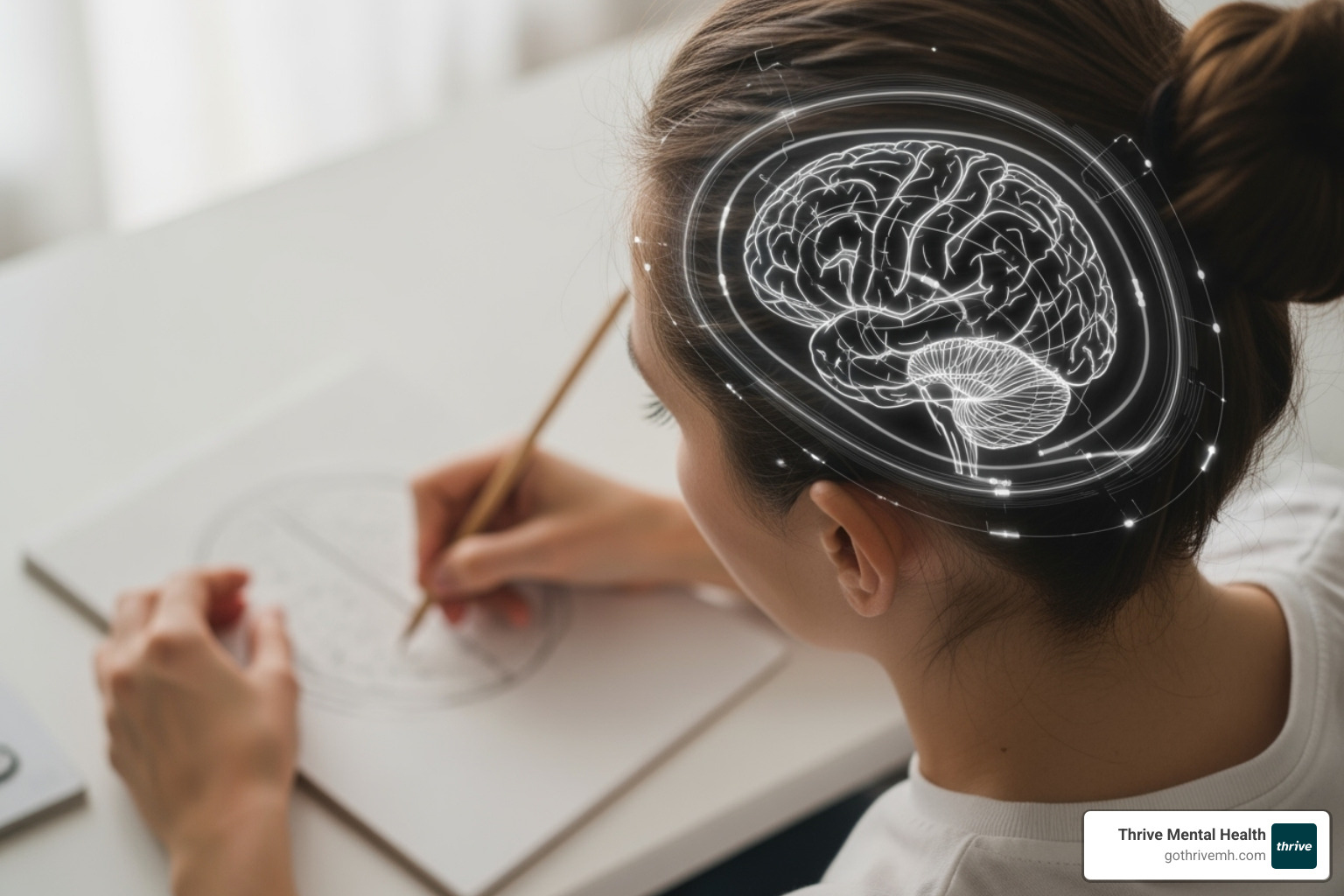
This neurological shift is crucial for emotional regulation. When your amygdala isn’t firing on all cylinders, your prefrontal cortex—the brain’s CEO for rational thinking—can do its job. You move from fight-or-flight mode into a state of calm clarity. The Influence of Art Making on Anxiety: A Pilot Study shows measurable reductions in stress hormones like cortisol after art-making sessions. These benefits don’t require artistic talent; the healing happens in the doing, not the final product.
How to Start Your First Anxiety Monster Drawing: A Step-by-Step Guide
Ready to create your first anxiety monster drawing? The most freeing part is that you don’t need to be an artist. This isn’t about creating a masterpiece; it’s about giving your feelings a face. The messy scribbles, wonky proportions, and mismatched colors are all perfect because they’re yours. A stick figure with worried eyes can be just as powerful as an elaborate dragon.
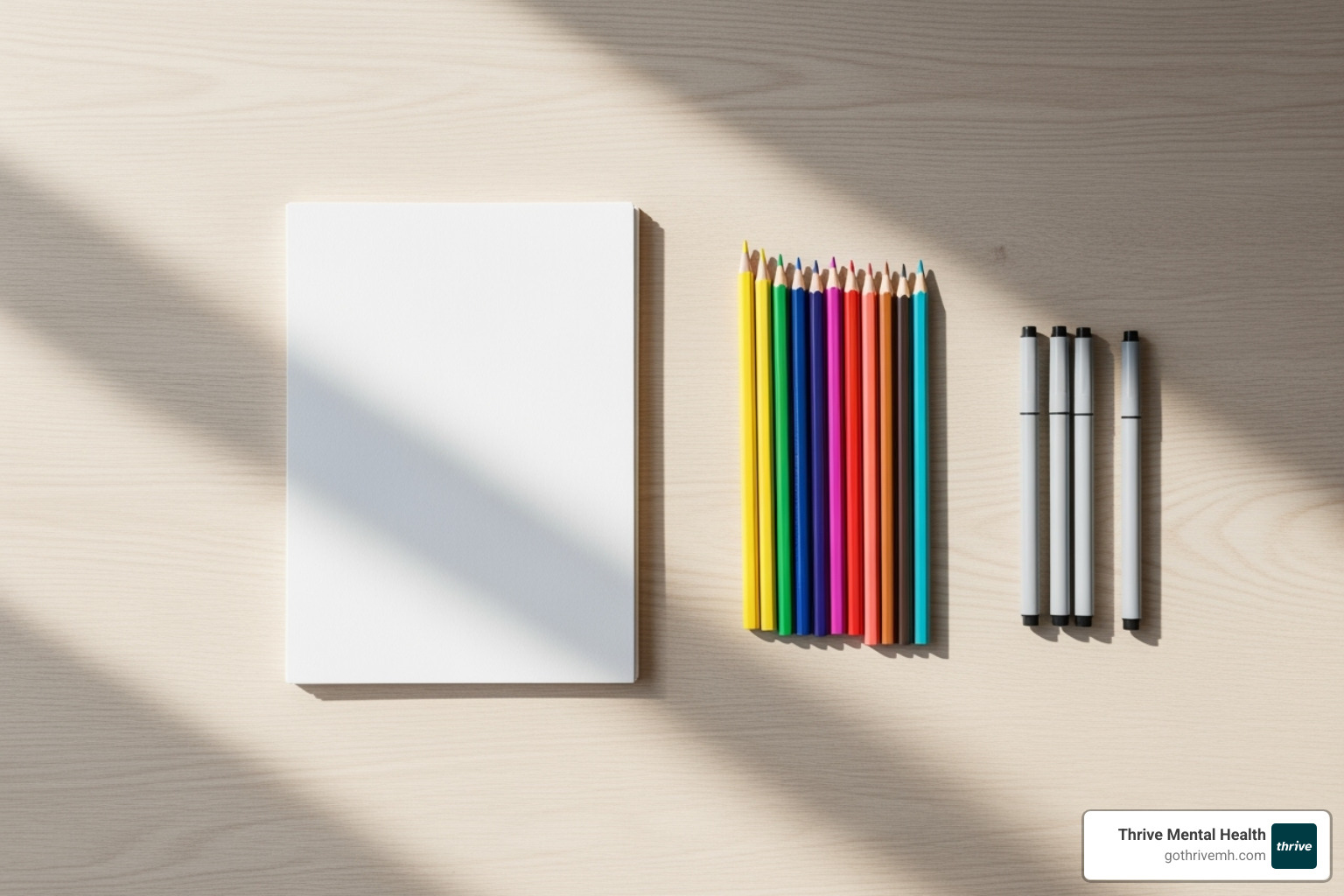
Let go of perfection. Your anxiety monster might be a fluffy cloud with too many eyes or a tangle of dark lines. Both are exactly right. For more ideas, check out our Mental Health Art Activities.
Step 1: Check-In with Your Body and Mind
Before you begin, pause and turn inward. Take a few slow breaths and scan your body. Where does your anxiety live today? Is it a tightness in your chest, a stone in your stomach, or buzzing energy in your head? Notice if it feels hot or cold, heavy or light, sharp or dull. Don’t judge what you find. Your body is giving you clues about what your monster might look like.
Step 2: Gather Your Supplies and Visualize
Grab whatever you have on hand—a pen and paper, crayons, markers, or a digital app. Even Buddha Boards work well, as their temporary nature removes any pressure. Now, imagine your anxiety as a creature. Let your mind wander: What does it eat? Does it have a name? What are its powers? Where does it live? What sounds does it make? Is it heavy or light? The more details you create, the less mysterious and scary your anxiety becomes.
Step 3: Let It Flow onto the Page
Now, let your anxiety guide your hand across the paper. If your anxiety feels chaotic, let your lines be chaotic. Scribble, make heavy marks, or press deep into the paper. If it feels shaky, accept those trembling lines—they’re telling your anxiety’s story. Don’t worry about mistakes. Erasing, crossing out, and do-overs are all part of the process. There are no rules. The simple act of moving those internal sensations onto paper is what creates healing.
Step 4: Tips for Kids and Teens
Young people often connect with the idea of “Worry Monsters.” Help them see anxiety as an overprotective pet that needs gentle training. You can make this more powerful by creating alongside them and asking open-ended questions about their monster’s details: how many heads it has, if it can fly, or what its skin feels like. The goal isn’t to eliminate the monster but to make it less mysterious. Resources like Taming The Anxiety Monster: Visualization Tools For Kids offer more age-appropriate guidance. The key is helping young people externalize their fears so they become something they can work with.
Prompts and Ideas to Inspire Your Inner Artist
Sometimes, even when you’re ready to create, you might hit a creative wall. That’s normal! Your anxiety might show up as a fierce dragon, a tiny worried creature, or an abstract swirl of color. The goal is to find what feels authentic to your experience. Think of this as character development for your feelings. For more creative approaches, explore our Therapeutic Art Activities.
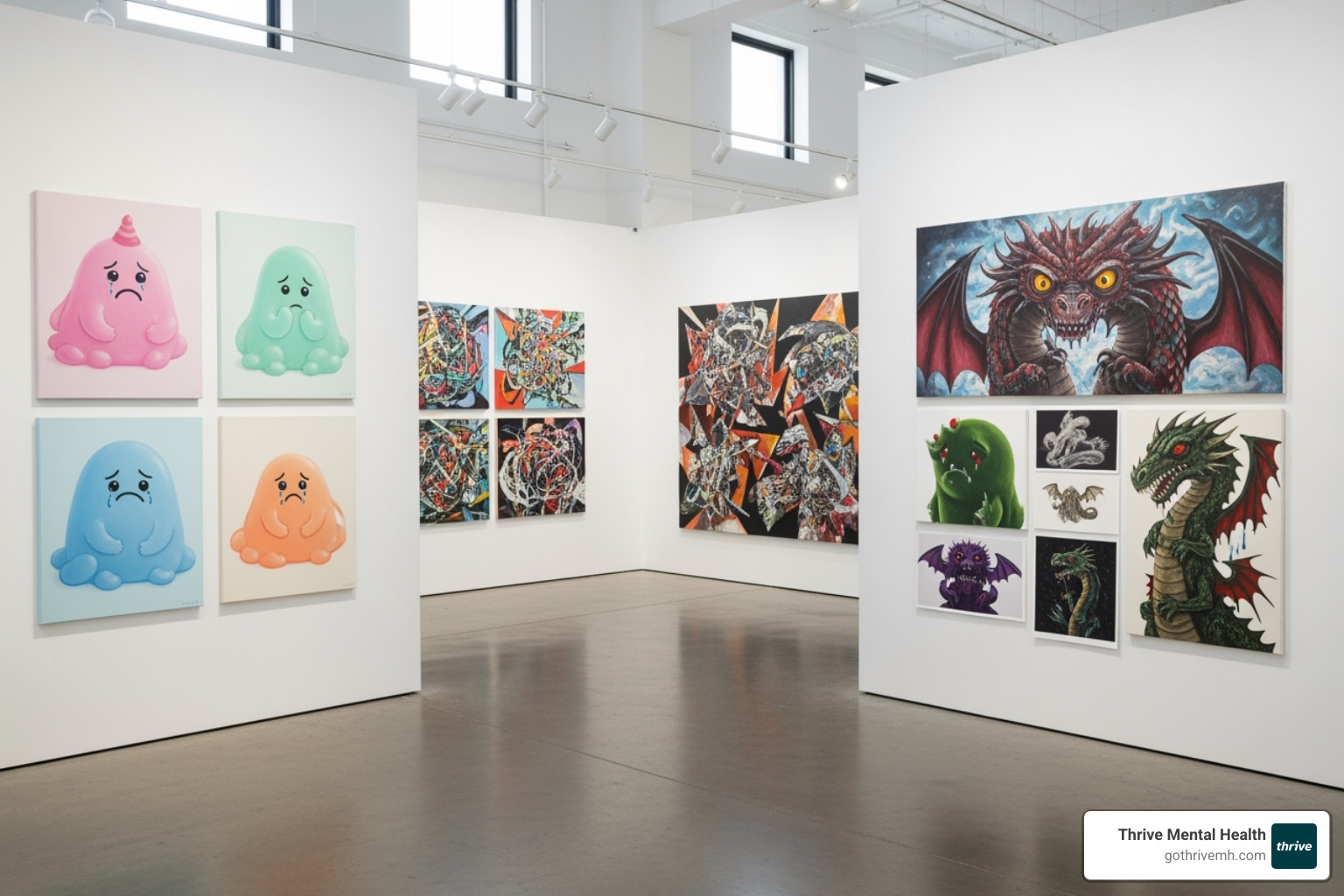
Prompts for Your Anxiety Monster Drawing
If you’re feeling stuck, get curious about your anxiety’s personality. Consider these prompts:
- What does it eat? (e.g., your sleep, your confidence)
- Does it have a name? (e.g., “Buzzy,” “The Overthinker”)
- What are its powers? (e.g., makes you freeze, sends thoughts spinning)
- Where does it live? (e.g., in your chest, in your stomach)
- What sounds does it make? (e.g., a whisper, a roar, a hum)
- Is it heavy or light?
Exploring Different Styles for Your Anxiety Monster Drawing
Your anxiety monster drawing can take any form. Try one of these styles:
- Abstract scribbles: A tangled mess of lines or a dark, stormy cloud.
- Detailed creatures: Use scales, multiple eyes, or intricate patterns.
- Symbolic representations: Draw heavy chains, a thorny bush, or a stormy sea.
- Shadow figures: Create a looming figure that follows you.
- Cute but creepy: A small, seemingly harmless but unsettling creature.
- Cartoon style: Make it a bit silly to reduce its threatening feel.
Notable Examples and Projects
The idea of turning mental health struggles into art has inspired incredible projects. Toby Allen’s Real Monsters is influential for showing how character design can help people talk about complex conditions. Online communities on sites like DeviantArt are full of people sharing their own anxiety monsters, from ‘Anxious Hug Monsters’ to ‘Anxiety Dragons.’ One example is the ‘Real Monsters Reboot- Anxiety by ZestyDoesThings on DeviantArt’ project, which you can explore here: Real Monsters Reboot- Anxiety by ZestyDoesThings on DeviantArt.
What to Do After You’ve Drawn Your Monster: Interacting for Emotional Release
Creating your anxiety monster drawing is just the beginning. The real change happens when you interact with your creation. This is where emotional processing and catharsis begin, helping you gain mastery over your feelings. Now that your anxiety is on paper, you decide what happens next. This active engagement is crucial for Building Resilience Online: Coping Strategies for Long-Term Mental Health. You have three main paths forward.
Option 1: Confront Your Monster
Sometimes, the most powerful thing you can do is assert control and set boundaries. Once your monster is on paper, it’s no longer inside you calling the shots. Try writing powerful statements on your drawing, like “I am Strong!”, “You don’t scare me!”, or “I am Safe!” You can also talk back to it. If it whispers anxious thoughts, respond, “Thanks for looking out for me, but we’re safe.” This symbolic act reinforces your agency.
Option 2: Comfort Your Monster
Not every anxiety needs to be fought. Sometimes, your monster might look small or frightened. In these cases, offering compassion can be more healing. Acknowledge that your monster might have good intentions, even if its methods are unhelpful. Try reassuring it like you would a scared child or pet: “It’s okay, we’re safe. You don’t need to worry right now.” This approach helps you practice self-compassion, integrating the anxious part of yourself rather than rejecting it.
Option 3: Dispose of Your Monster
For many, the most cathartic step is symbolically releasing their anxiety. Once you’ve given your feelings form, you might be ready to let them go.
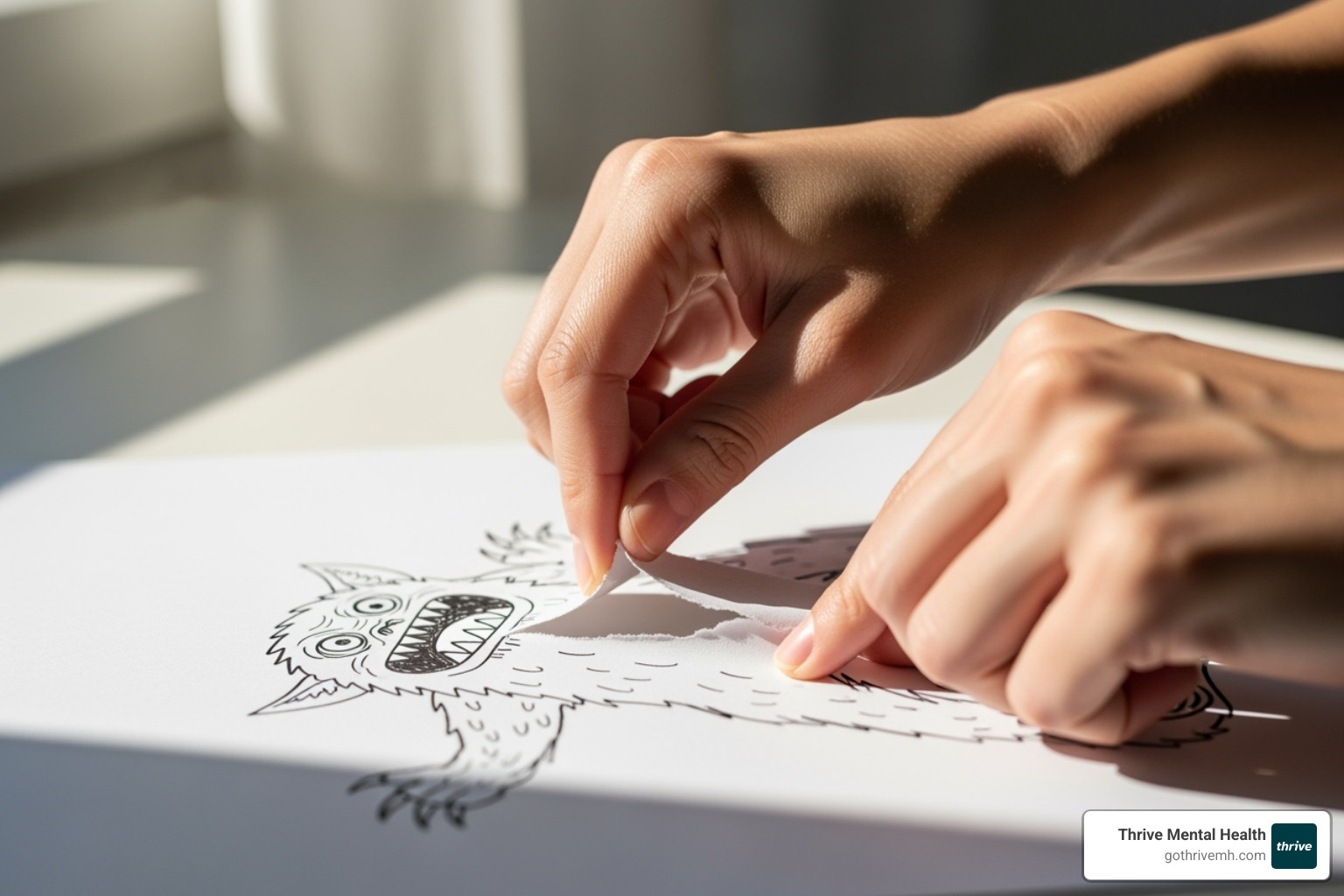
Ripping or shredding your drawing can be incredibly satisfying. Burying it can symbolize putting the worry to rest. You could also create a “Good-bye Monster” box to seal it away. This act of disposal is a powerful ritual that symbolizes your choice to release the power your anxiety holds over you, often bringing a profound sense of closure and relief.
Frequently Asked Questions about Anxiety Monster Drawing
Here are answers to the most common questions we hear about anxiety monster drawing.
What if I’m not good at drawing?
Your artistic skill level doesn’t matter at all. The goal is expression, not perfection. You’re not being graded or judged. The focus is on the process of externalizing your feelings. Scribbles, stick figures, and abstract shapes are just as valid and effective as detailed illustrations. What matters is that you are giving your anxiety a form that makes sense to you. The therapeutic benefit happens in the act of putting pen to paper.
How is this different from professional art therapy?
Creating an anxiety monster drawing is a self-guided coping technique for immediate emotional processing. You can do it anytime, with any supplies. Professional art therapy is a structured approach facilitated by a trained and licensed art therapist. A therapist helps you explore deeper meanings, process complex trauma, and integrate insights into a broader treatment plan for conditions like Anxiety Disorders. At Thrive Mental Health, we often use Art Therapy Techniques You Can Try at Home for Emotional Well-being as part of our intensive programs. The two approaches can complement each other beautifully.
Can I draw monsters for other feelings besides anxiety?
Absolutely! This technique is versatile and can be adapted for any difficult emotion. Depression might look like a heavy blanket creature. Anger could have sharp teeth and fiery breath. Stress might appear as a tangled knot monster. Giving any overwhelming feeling a physical, external form makes it less mysterious and more manageable. Naming negative feelings is a concept widely used in therapy to help people gain control over intrusive thoughts.
Conclusion
When anxiety feels overwhelming, it’s easy to forget your own power. The simple act of creating an anxiety monster drawing can be a game-changer. Instead of being trapped by anxious thoughts, you can put them on paper and observe them from the outside. This isn’t just a creative exercise—it’s backed by science. When you draw, your brain’s fear center calms down, and you actively rewire your brain to respond differently to stress.
This technique is simple and accessible. You don’t need to be an artist; a pen and paper are enough to turn abstract fears into something concrete. Whether you confront your monster, comfort it, or dispose of the drawing, you are taking control of your emotional experience. You are not your anxiety; you are someone who experiences anxiety.
At Thrive Mental Health, we see anxiety monster drawing as one valuable tool in a comprehensive approach to mental wellness. When you’re ready to explore deeper healing, creative techniques like this can be integrated into professional treatment.
If you’re curious about how art therapy might fit into your mental health journey, we’d love to help you Explore how Art Therapy can be part of your healing journey. Your path to feeling better is unique, and we’re here to support you with flexible, evidence-based care.
3 thoughts on “Anxiety Monster Drawing 101 – Artfully Conquer Your Fears”
Comments are closed.